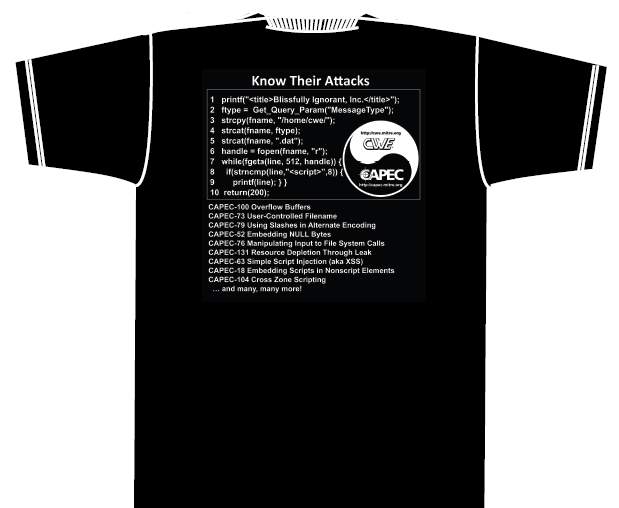|
| 1 | printf("<title>Blissfully Ignorant, Inc.</title>"); |
| 2 | ftype = Get_Query_Param("MessageType"); |
| 3 | strcpy(fname, "/home/cwe/"); |
| 4 | strcat(fname, ftype); |
| 5 | strcat(fname, ".dat"); |
| 6 | handle = fopen(fname, "r"); |
| 7 | while(fgets(line, 512, handle)) { |
| 8 | if (strncmp(line,"<script>",8)) { |
| 9 | printf(line); } } |
| 10 | return(200); |
This code represents an application that reads an untrusted file that was previously uploaded into a restricted directory. It selects the file depending on the value of the MessageType parameter, then displays the file as a web page.
It was developed with the following principles:
This code is called a Bug Barrel: there are so many bugs, finding them is as easy as shooting fish in a barrel (or, alternately, it's more fun to exploit than a barrel of monkeys).
On the front side, we used CWE IDs to list each weakness in the Bug Barrel. When a chain of weaknesses introduced a vulnerability, we would use a "->" (arrow) to indicate the relationships between the chain links.
CWE-24: Relative Path Traversal (2 -> 4 -> 6)
CWE-120: Classic buffer Overflow (2 -> 4 -> 10)
CWE-20: Improper Input Validation (2 & 8)
CWE-73: External Control of File Name or Path (2 -> 4 -> 6)
CWE-116: Improper Encoding or Escaping of Output (7 -> 9)
CWE-79: Failure to Preserve Web Page Structure (XSS) (7 --> 9)
CWE-404: Improper Resource Shutdown or Release (6 -> 10)
CWE-134: Uncontrolled Format String (7 -> 9)
CWE-252: Unchecked Return Value (2 > 4 -> 6)
CWE-476: NULL Pointer Dereference (6 -> 7)
On the back side, we used CAPEC IDs to list each attack that could be attempted against the Bug Barrel.
CAPEC-100: Overflow buffers
CAPEC-73: User-Controlled Filename
CAPEC-79: Using Slashes in Alternate Encoding
CAPEC-52: Embedding NULL Bytes
CAPEC-76: Manipulating Input to File System Calls
CAPEC-131: Resource Depletion Through Leak
CAPEC-63: Simple Script Injection (aka XSS)
CAPEC-18: Embedding Scripts in Nonscript Elements
CAPEC-104: Cross Zone Scripting
... and many, many more!
The yin/yang logo symbolizes the inter-relationships between attacks and weaknesses: each is dependent on the other.
2009 T-Shirt Front:

2009 T-Shirt Back:
